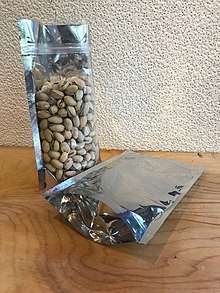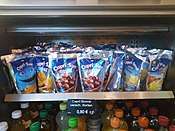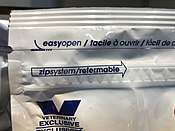Stand-up pouch
Stand-up pouch, also known as Doypack (a trademark associated with the pouch), is a type of flexible packaging which is able to stand erect on its bottom for display, storage, and use.[1] It is a type of plastic bag but sometimes also has plastic bottle characteristics. Doypacks are commonly used for powders or ready-to-drink beverages. The bottom part of a stand-up pouch is gusseted to provide support for display or use.[2]




They can be aseptically filled or filled on normal packaging lines.[3]
History
Early work on stand-up pouches was conducted in France by Leon and Louis Doyen.[4][5] Louis Doyen was president of Thimonnier Company which trademarked the name "Doypack" (from DOYen ‘'PACKaging).
Development of materials, design options, and equipment increased in the 1980s and 1990s. It is currently a very widely used package form.
Construction
The flexible pouches are usually constructed of multi-layer materials: various plastic films, paper, foil, etc. Pouches are often printed with high-impact graphics or sometimes attached labels. The materials must have specialized heat-seal properties to allow conversion into pouches.
The most common pouch has bottom gussets to form a "W" which opens to allow a flat bottom. Side gussets are also sometimes used. Several design options are available.[6]
Inclusion of pour spouts and reclosable zip strips are common.
Equipment
The packaging machinery involved typically forms the pouch from preprinted roll stock. The preformed pouches are shipped to a packager where they are filled and the top is sealed.
The alternative is an integral form-fill-seal machine, whether vertical or horizontal. The equipment forms the pouches, fills the pouches in-line, and seals them. With foods, drinks, or medical products, special sanitizing and wash-down requirements are critical.
The resulting equipment is sometimes complex and expensive. Packagers who do not have the volume to fill a machine to its capacity often use contract packagers.
References
- Greely, MJ (2010), "Standup Flexible Pouches", in Yam, K L (ed.), Encyclopedia of Packaging Technology, Wiley, pp. 1155–1159, ISBN 978-0-470-08704-6
- Soroka, W (2008). Illustrated Glossary of Packaging Terminology (Second ed.). Institute of Packaging Professionals. p. 170.
- Jones, R T (9 September 2009). "From Doy-Pack to S-Pouch". Packaging Digest: 58–63. Retrieved 6 August 2019.
- US3935993A, Doyen, "Free-standing container", published 1973
- US3502521A, Doyen, "Method of producing plastic containers", published 1966
- United States Patent Classification B65D75/008, Standing pouches, US Patent Office
Bibliography
- Soroka, W, "Fundamentals of Packaging Technology", IoPP, 2002, ISBN 1-930268-25-4
- Yam, K. L., "Encyclopedia of Packaging Technology", John Wiley & Sons, 2009, ISBN 978-0-470-08704-6